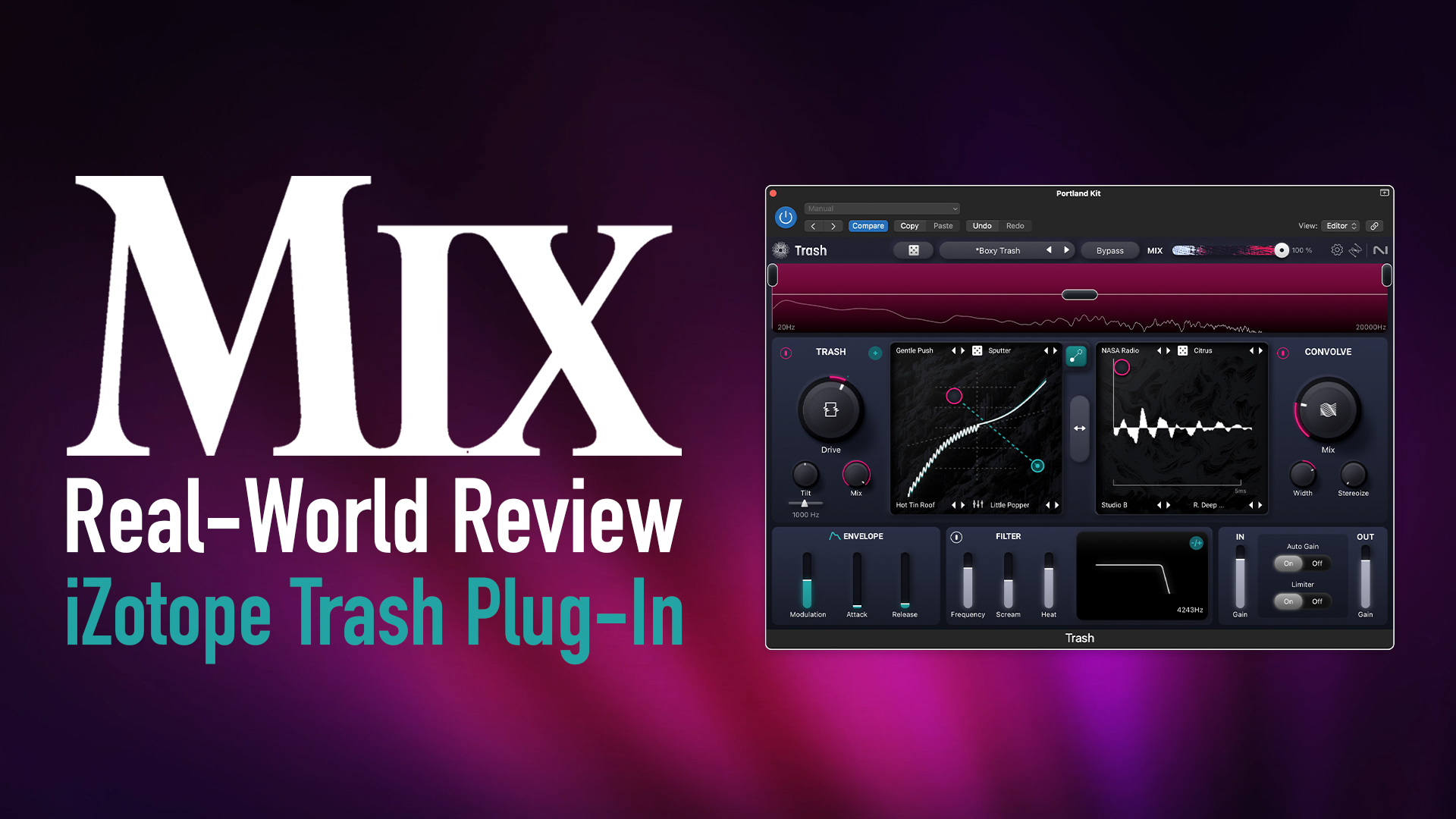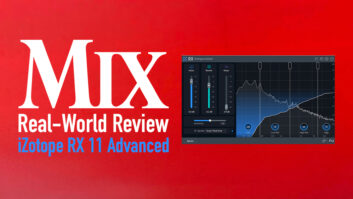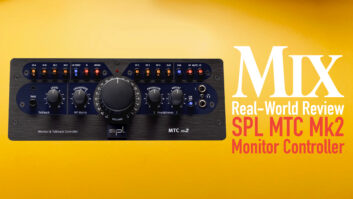
| MIX VERDICT: IZOTOPE TRASH |
| THE TAKEAWAY: “Trash will be a boon to anyone who uses distortion creatively. Sonically, it’s particularly well-suited for producers of hip-hop and electronic dance music.” |
| COMPANY: iZotope • www.izotope.com PRICE: Desktop version: $79 ($29 upgrade for Trash 2 owners); iPad version: $79 PROS: • Excellent sound. • Huge selection of distortion varieties. • XY pads allow unlimited sonic blending. CONS: • Many distortion types have non-descriptive names. • Trash 2 owners won’t like exclusion of Dynamics, EQ and Delay modules. • Mic choices for IRs offer little difference. |
IZotope recently released Trash, a brand-new incarnation of its iconic distortion plug-in, which came out in 2003 and last had a major update—to Trash 2—in 2012.
Since then, Trash 2 has retained an enthusiastic following, but the code it runs on is outdated, and iZotope officially discontinued it in 2022. It still works on many systems (I can launch Trash 2 on my M2 Pro Mac), but there’s no guarantee for how long as it’s not receiving maintenance updates.
The new Trash was rewritten from the ground up but, a bit confusingly, shares the same name as the original. An iZotope spokesperson told me that the company decided not to call it Trash 3 because it’s not an update of Trash 2; it’s a full reimagining of Trash. Despite many similarities, its code has been completely rewritten and its architecture has changed significantly.
One of the major differences is a redesigned user interface with a modern, dark look and an integrated, single-screen design. The latter makes navigation easier than in Trash 2, which requires moving between multiple screens and menus.
iZotope also streamlined the features to focus on the plug-in’s core functions of distortion and convolution. Gone are the Dynamics, EQ and Delay modules, along with one of the filters from Trash 2—but I wouldn’t call the new Trash stripped down. It adds powerful XY Pads that let you morph between multiple distortion types or impulse responses, and introduces randomization into the workflow.
iZotope also offers a fully featured iPad version of Trash, which is compatible with Logic Pro for iPad. It’s a separate purchase at the iOS App Store. For this review, I used the desktop version.

SLEEK AND SLICK
The new interface is centered around the large Trash and Convolve modules. Additional control sections reside across the top and bottom, including those for the Multiband display, Envelope (follower), Filter and more.
The Trash module features a square-shaped XY Pad that simultaneously holds four different distortion types, one in each corner, which can be selected from a dropdown menu of nearly 70 varieties.
iZotope organized the distortion types into descriptively named categories: Distort, Drive, Faulty, Fuzz, Heavy, Retro, and Saturate.
Each category offers multiple choices. Some have obvious names, such as Tape, Blues Driver, Amperical, and Triangle Clipper, that give you an idea of what you’re getting. Others, like Citrus Pulp, Soft Taco and Cracked Actor, are more ambiguous, though you can audition them for a taste of what they sound like.
The XY Pad, then, changes the balance between the four types based on the positioning of the large red node. The closer it moves to one of the corners, the more that distortion type gets emphasized. By blending four different distortion varieties, you are able to create unique combinations efficiently. If you only want one kind of distortion, just move the node fully into the corresponding corner of the XY Pad.
Several adjustable parameters are available within the Trash module: The Drive knob governs the intensity of the distortion by increasing or decreasing the input gain. The Mix knob is a dry/wet control, which also impacts the intensity.
Oeksound Bloom — A Mix Real-World Review
The display in the Trash XY Pad offers visual feedback in the form of a transfer curve, a line that the manual (which is well-written and comprehensive) defines as representing “the relationship between the input level (X-axis) and the output level (Y-axis).” It changes shape in real-time as you drag the node around the pad or adjust the input gain.
The Tilt equalizer lets you adjust the center frequency and boost or cut the gain at the module’s output. Trash 2 fans will likely miss the dedicated EQ module, but the Tilt EQ is effective, although it’s more like a blunt instrument than a surgical tool.
The Trash module interacts directly with the Envelope (modulation) section, which features an envelope follower that you can assign to the Trash (input gain), the XY pad and the frequency control of the (low-pass) Filter section. The modulation can create everything from subtle movement to wild effects, depending on the settings. Controls include Modulation, Attack and Release.
When you assign modulation to the XY Pad, a visible path (a dotted line) is created between the primary node and a smaller blue one—also movable—that appears. The path depicts the modulation speed and behavior in real-time.
The Filter section features a low-pass filter with Frequency, Scream (resonance amount) and a parameter called Heat, which boosts the input gain and causes the Filter to saturate. The Heat slider quickly became my go-to because it almost always improved the distortion and added excitement. If you use high Heat settings, it’s prudent to turn on the Auto Gain and Limiter switches, located between the Input and Output sliders. Otherwise, you could experience sudden jumps in volume and clip the output. Another way to tame an overly distorted setting is to use the global Mix slider near the top of the GUI, which allows you to blend dry audio with the post-effects signal at Trash’s output.
BE IMPULSIVE
When a new plug-in instance is opened, Convolve comes after Trash in the signal chain, but you can instantly reverse their order with a press of the aptly named Swap button in the center of the GUI. Flipping their positions can significantly change the sound. Convolve is first in many of Trash’s factory presets.
Like the Trash module, Convolve features an XY Pad to load and blend four choices, except here it loads impulse responses. iZotope equipped Trash with a generous collection of nearly 300 IRs sorted into 14 categories, with names such as Amps, FX, Body, Animals, Vowels, Textures, Reverb and Water. The overall collection offers a vast array of sounds from an extensive range of sources, including a guitar amp, a barking dog, a metal bowl and a cheap radio. Blending the IRs in with the distortion from the Trash module can add significant depth and color.
For most IRs, you can choose between a version recorded with a condenser, dynamic or ribbon mic. The differences were much more subtle than I expected, so I never felt a need to change between mic types. A category called Custom is provided so that you can load your own IRs, using any audio file. The manual recommends keeping the files to one second or shorter.
From a control standpoint, the Convolve module is simple. The large Mix knob brings the sound of the IRs into the signal path. Also available are utilities for stereo-izing mono IRs and adjusting stereo width.

CREATING CHARACTER
If you’re not into creating settings from scratch, Trash features plenty of factory presets organized into categories by source type (Guitar, Drums, Vocals, etc.) and other factors.
For quickly changing a sound’s character, iZotope included Randomize buttons that look like dice in the Trash and Convolve modules and the Preset selector. Pressing the one in Trash randomly changes the distortion types loaded into the XY Pad. In Convolve, the IRs get switched. For the presets, it randomly selects and loads another.
I initially thought the randomization buttons were a bit gimmicky, but I’ve since come around. With so many distortion types and IRs to choose from—and with four slots to load in each module—it’s sometimes quicker to keep hitting the Randomize buttons until you find a setting you like.
A Multiband feature, accessed from the Multiband display that runs across the top, adds a lot of power by allowing users to globally split the processing into three user-adjustable frequency bands, each with entirely different settings. With Trash’s ability to load four distinct distortion types and four IRs in each frequency band, that opens up a lot of tweakable territory.
To create a frequency band, you drag the Crossover Frequency handles on the left and right of the Multiband display to whatever frequencies you want as crossover points. Each Band has an adjustable Gain control. Solo buttons are included per band for auditioning.
Some Trash 2 users have expressed their disappointment that the new Trash isn’t a conventional update that brings back the legacy features and adds new ones. That was to be expected.
Although Trash’s feature set isn’t as broad as the one in Trash 2, it’s more focused on its prime objective: creating distortion. Plus, it’s intuitive enough for studio novices but offers plenty of settings depth for those who like to geek out.
Trash will be a boon to anyone who uses distortion creatively. Sonically, it’s particularly well-suited for producers of hip-hop and electronic dance music. With its ability to load and morph between IRs, it will also be a potent sound design tool.
Trash has something even more important going for it: It sounds massive. Whether you’re livening up a boring drum loop, creating a cool vocal effect, bathing an electric piano in warm overdrive or using a combination of distortion and amp IRs for an electric guitar track, I predict you’ll find the new Trash a potent and creative distortion tool.







